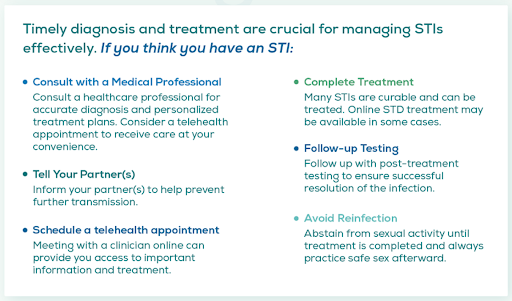
5 Safe Sex Practices to Help Avoid STDs
Medically reviewed by Rosanna Sutherby, PharmD on October 13, 2020. To give you technically accurate, evidence-based information, content published on the Everlywell blog is reviewed by credentialed professionals with expertise in medical and bioscience fields.
Table of contents
- 1) Wear a Condom
- 2) Consider Mutual Monogamy
- 3) Limit Number of Sexual Partners
- 4) Open Communication
- 5) Get vaccinated
- Regular STD Testing Is Key
- When do STD symptoms start?
- Conclusion
- Related Content
Knowing that you’re proactively taking steps to keep yourself safe from sexually transmitted infections (STIs/STDs) can give you greater peace of mind during sex, but what safe sex practices should you use to help prevent STDs and protect you and your partner?
Below, you'll find a few pointers on how to practice safe sex-with 5 safe sex tips to consider applying to your sex life. Additionally, regular testing plays a crucial role in safe sex practices. Consider getting an STD test for men or an STD test for women to ensure you and your partner are staying safe.
Let’s kick things off with this first item on the list:
1) Wear a Condom
One of the best safe sex practices to avoid STDs is to wear a condom. Correct use of a male condom throughout the duration of sexual intercourse (whether it be anal, vaginal, or oral sex) effectively reduces STD transmission. You can use both latex and non-latex condoms, though it’s important to note that synthetic non-latex condoms have a higher breakage rate. The CDC also does not recommend natural membrane condoms for STD prevention.
Using a polyurethane condom is often suggested for people who have a known latex allergy. These are thinner, which increases sensitivity but also means they might be more prone to breaking.
Many people wonder, “Can you get an STD with a condom?” It turns out that a condom does not guarantee 100% protection against STD transmission. With that said, having protected sex is still one of the most important (and effective) methods for reducing your risk.
2) Consider Mutual Monogamy
If you’re wondering how to prevent STDs, you may want to consider mutual monogamy. When you’re mutually monogamous, you’ve agreed to be sexually active with just one sexual partner, and vice versa. One of the best ways to prevent the sexual transmission of diseases like HIV, chlamydia, gonorrhea, and more is for both partners to remain monogamous.
3) Limit Number of Sexual Partners
This is related to the above, but it’s worth mentioning that limiting how many sexual partners you have is among the safe sex practices that can help decrease your risk—even if you aren’t monogamous with anyone. Of course, curbing the number of sex partners you have might not suit your sexual lifestyle—and that’s okay! Knowing that having multiple sex partners is an STD risk factor can motivate you to get tested more regularly and encourage the same for your partners.
(Related: At-Home STD Test - Female | At-Home STD Test - Male)
4) Open Communication
Openly communicating about your sexual histories with a new sexual partner is sometimes easier said than done. But being open and honest with your partner about your sexual history and your test results can be one of the most important (and empowering) safe sex practices. (Related: “How do I ask my partner to get tested?”)
5) Get vaccinated
The most common STD is HPV, but fortunately, there’s a vaccine that can prevent it. HPV is a sexually transmitted infection that—in some cases—can lead to the development of various cancers, especially cervical cancer (high-risk HPV types are the main cause of cervical cancer in women). Testing for HPV can help detect its presence early. Consider taking an HPV test to know your status. We also offer an HPV Female Test, designed specifically for women.
The CDC’s recommendation is that both girls and boys from ages 11 to 12 should get a vaccine (though the vaccine can start at age 9) through age 26 (if not already vaccinated). After age 26, talk to your healthcare provider about HPV vaccination and whether it’s right for you.
Regular STD Testing Is Key
If you are sexually active with more than one partner, consider getting tested regularly for STDs. You can visit a clinic to get your testing done, but at-home testing is another option. To comfortably and discreetly check for STDs from the convenience of your home, you can take an at-home STD test for men or an at-home STD test for women.
If you’re wondering how often you should get tested for STDs, here are some guidelines from the CDC:
Adults and adolescents between the ages of 13 and 64 should get tested at least once for HIV.
-
Women who are sexually active and under age 25 should test every year for chlamydia and gonorrhea.
-
Women older than age 25 who have new or several sex partners (or a sex partner with an STD) should also test annually for gonorrhea and chlamydia.
-
Starting in early pregnancy, pregnant women should test for HIV, syphilis, and hepatitis B. Those at increased risk should also test for chlamydia and gonorrhea. Regular testing as needed is recommended.
-
Gay or bisexual men who are sexually active should test annually for the following STDs: syphilis, gonorrhea, and chlamydia. If you are sexually active with more than one partner, it’s recommended that you get tested more often than once a year.
-
People who engage in unsafe sex or who share injection drug equipment should be tested for HIV at least yearly.
Keep in mind that these are general guidelines, so it’s best to talk with your healthcare provider to learn what STD testing frequency they recommend for you.
When do STD symptoms start?
STD symptoms can begin at varying times, from a few days to several weeks after exposure. For some, they are immediate, while for others, it might take longer, with some infections remaining asymptomatic for months or even years. Signs to watch for could include unusual discharge, itching, sores, or pain during urination or intercourse. For more information on potential symptoms, consider learning about Understanding STD Vaginal Discharge Colors or Uncommon STD Symptoms. The unpredictability of symptom onset makes regular testing essential, especially if you've had unprotected sex or multiple partners. Some STDs might not show any symptoms at all; understanding What STDs Are Asymptomatic is also crucial. Early detection allows for prompt treatment and reduces the risk of spreading infections to others. If you're concerned about STDs, consult a healthcare provider for advice and testing.

Conclusion
Protecting your sexual health is important, and with the right safe sex practices, you can significantly decrease your risk of getting—or transmitting—an STD. Proactively checking for STDs on a regular schedule is another key step you can take to keep yourself and your partner(s) safe.
If you want to check in on your status from the comfort and privacy of your home, consider our at-home STD testing options. Our STD test for men and STD test for women lets you easily check for the following 6 common STDs:
- Chlamydia
- Gonorrhea
- Hepatitis C
- HIV
- Syphilis
- Trichomoniasis
We also offer specific tests for each STD, such as our Chlamydia & Gonorrhea Test, allowing you to focus on individual concerns. If you receive positive results, you'll have the option to connect with our independent physician network (at no extra cost) to talk through your results and potentially receive a prescription for medication, if appropriate. We also have telehealth services to support you with STD treatment online, ensuring you receive the care and guidance you need from the comfort of your home.
Related Content
Let’s Talk About Safe Sex: How to Talk About STIs/STDs With a New Partner
Is it Safe to Have Sex During Your Period?
References
1. How You Can Prevent Sexually Transmitted Diseases. Centers for Disease Control and Prevention. URL. Accessed November 13, 2020.
2. Sexually transmitted diseases (STDs). Mayo Clinic. URL. Accessed November 13, 2020.
3. Condoms. Cleveland Clinic. URL. Accessed November 13, 2020.
4. Which STD Tests Should I Get?. Centers for Disease Control and Prevention. URL. Accessed November 13, 2020.
Rosanna Sutherby, PharmD holds a PharmD and is a retail pharmacist who has worked in the industry for roughly 20 years. Sutherby has extensive knowledge about medications, diseases, and conditions, and knows how to confidentially educate patients. Sutherby also creates content revolving around anything in the medical sphere with a focus on conditions and articles. Her published work has appeared in Managed Healthcare Executive, Formulary Watch, and PsychCentral, and spans a variety of topics, including cardiovascular health, immunology, sleep disorders, mental health, alcohol and opioid use disorders, vaccine education, and medication use and safety.
